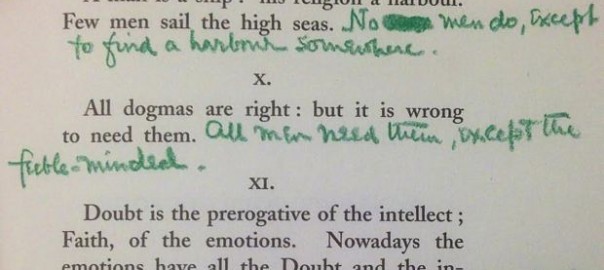Hi, Welcome
Welcome back
Sacred Mysteries: G K Chesterton left penetrating additions in green crayon on a copy of a book by a celebrity — at the time


No one is so obscure as a once-famous journalist, and by mentioning George Holbrook Jackson (1874-1948) I do not mean to recommend his works.
In the first decade of the 20th century, Holbrook Jackson was pretty well known among the journalistic intelligentsia to which the era pretended. In 1900 he met the absurd figure of A R Orage (an admirer of Gurdijeff) in a Leeds bookshop and lent him a copy of Nietzsche’s Also sprach Zarathustra, receiving in return a copy of the Bhagavad Gita. He also acquired Mrs Orage, who was fed up with her husband Dickie’s infatuation with Beatrice Hastings, a sort of bohemian Theosophist.
This then, was the Holbrook Jackson, co-editor with Orage of The New Age (“An Independent Socialist Review” backed financially by George Bernard Shaw) who in 1911 published a volume of aperçus called Platitudes in the Making, a title that might have been thought to offer something of a hostage to fortune.
But fortune smiled on the book in a most unexpected way. Instead of being utterly forgotten, a copy was found in a second-hand bookshop in San Francisco in 1955. What made the find interesting was that the whole book had been annotated in green crayon by G K Chesterton (to whom Jackson had given it when it came out). The characteristic curly handwriting is quite legible and the unusual thing, for annotations, is that they cover the entries from beginning to end and are of the most thoughtful kind. The resultant dialogue is far more penetrating than the original book.
The annotated version was published in facsimile in 1997, under the title Platitudes Undone, and my copy fell off the shelf last week, making me pick it up and read through it again. I’m glad I did.
Chesterton, it is important to remember, was a man of the Left. He was, from his youth, a friend of Christian Socialists. As William Oddie points out in his excellent book on the young Chesterton, Jackson’s own division of figures of the 1890s into poseurs, reformers and revolutionists would put Chesterton in the third category. It was in Robert Blatchford’s socialist Clarion that in 1904 Chesterton first outlined his ideas in favour of Christianity. Holbrook Jackson sought him out later that year, when he was staying in Yorkshire, and (as recounted in Ian Ker’s masterly biography of Chesterton) found him “leaning in the rain against a budding tree, absorbed in the pages of a little red book”. Chesterton’s annotations establish from the first page his profoundly different attitude to the world. “Truth is one’s own conception of things,” writes Jackson. “The Big Blunder,” responds Chesterton beneath, “All thought is an attempt to discover if one’s own conception is true or not.” Chesterton’s preference for paradox was never hospitable to platitudes. “Familiarity breeds not contempt, but indifference,” Jackson suggests. Chesterton adds: “But it can breed surprise. Try saying ‘Boots’ ninety times.” He is ready, though, to applaud Jackson if he finds something strikingly true. Under Jackson’s remark, “There is nothing old under the sun,” he is content to write, “Very good.” Chesterton does not share Jackson’s amorphous idea of belief. “No two men have exactly the same religion,” Jackson writes, “a church, like society, is a compromise.” Chesterton’s reply is: “The same religion has the two men. The sun shines on the evil and the good. But the sun does not compromise.” Chesterton becomes most exasperated when Jackson expresses the conventionally pessimistic social Darwinism in which his thought had developed. It is not a profanity that he employs when he responds to Jackson’s remark, “The most hopeful sign of the present age is the decline of the birth rate,” by writing underneath: “Christ! What an age!”
Follow comments on Telegraph.co.uk 
Telegraph Columnists: daily opinion, editorials and columns from our star writers
(328)
Report Post







